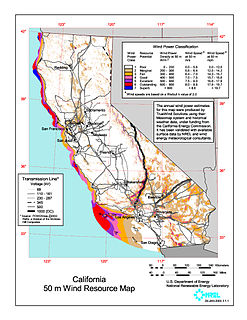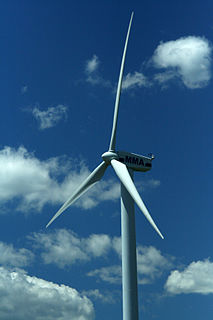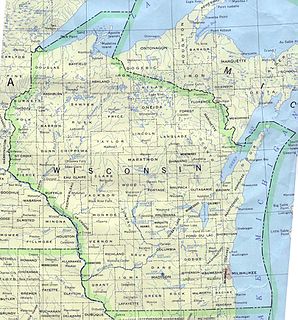
A wind farm or wind park, also called a wind power station or wind power plant, is a group of wind turbines in the same location used to produce electricity. Wind farms vary in size from a small number of turbines to several hundred wind turbines covering an extensive area. Wind farms can be either onshore or offshore.
The Cape Wind Project was a proposed offshore wind farm on Horseshoe Shoal in Nantucket Sound off of Cape Cod, Massachusetts, United States. It was approved but then lost several key contracts and suffered several licensing and legislative setbacks. The developer, Jim Gordon of Energy Management Inc., eventually terminated the lease rights for the site in late 2017.

Otis Air National Guard Base is an Air National Guard installation located within Joint Base Cape Cod, a military training facility located on the western portion of Cape Cod in Barnstable County, Massachusetts, United States. It was known as Otis Air Force Base prior to its transfer from the active duty Air Force to the Air National Guard. In the local community, it is more commonly known as Otis Air Base or simply Otis. It was named in honor of pilot and Boston surgeon Lt. Frank "Jesse" Otis.

Wind power is one of the main renewable energy sources in Australia and contributed 10% of electricity supplied in 2020, with 37.5% of total renewable energy supply. Australia has excellent conditions for harvesting wind power with abundant wind resources located close to population centres in the southern parts of the country and on the slopes of the Great Dividing Range in the east.

Wind power in Germany is a growing industry. The installed capacity was 55.6 gigawatt (GW) at the end of 2017, with 5.2 GW from offshore installations. In 2019, a quarter of the country's total electricity was generated using wind power, compared to an estimated 9.3% in 2010.

Wind power in California had initiative and early development during Governor Jerry Brown's first two terms in the late 1970s and early 1980s. The state's wind power capacity has grown by nearly 350% since 2001, when it was less than 1,700 MW. In 2016, wind energy supplied about 6.9% of California's total electricity needs, or enough to power more than 1.3 million households. Most of California's wind generation is found in the Tehachapi area of Kern County, California, with some large projects in Solano, Contra Costa and Riverside counties as well. California is among the states with the largest amount of installed wind power capacity. In recent years, California has lagged behind other states when it comes to the installation of wind power. It was ranked 4th overall for wind power electrical generation at the end of 2016 behind Texas, Iowa, and Oklahoma. As of 2019, California had 5,973 megawatts (MW) of wind power generating capacity installed.

Cape Cod Space Force Station is a United States Space Force station located in the northwest corner of Joint Base Cape Cod, United States, on Flatrock Hill in Massachusetts. Cape Cod Space Force Station began construction in 1976 as Cape Cod Missile Early Warning Station and was renamed Cape Cod Air Force Station in 1982, before assuming its current name in 2021.

The Joint Base Cape Cod is a state-designated joint base created by the Commonwealth of Massachusetts and the United States War Department in 1935. Governor James Curley signed the state bill to allocate and purchase land for a military facility, and establishing a formal commission to manage this new state military property and personnel. After 22,000 acres of land was secured in Cape Cod, the Massachusetts National Guard began erecting tents and a basic training program in the following year. Formerly the Massachusetts Military Reservation, it was renamed in 2013 to Joint Base Cape Cod by Massachusetts, although it has no federal recognition.

Community wind projects are locally owned by farmers, investors, businesses, schools, utilities, or other public or private entities who utilize wind energy to support and reduce energy costs to the local community. The key feature is that local community members have a significant, direct financial stake in the project beyond land lease payments and tax revenue. Projects may be used for on-site power or to generate wholesale power for sale, usually on a commercial-scale greater than 100 kW.

EDF Renewables is a wholly owned subsidiary of the French utility EDF Group, specializing in renewable energy production. As an integrated operator, the Group develops and finances the construction of renewable energy facilities, and manages operations and maintenance for its own account and for third parties.

The U.S. state of Massachusetts has vast wind energy resources offshore, as well as significant resources onshore. The 2016 update to the Clean Energy and Climate Plan had a goal of reducing 1990 baseline greenhouse gas emissions levels by 25% by 2020. Current goals include installing 3,500 megawatts (MW) of offshore wind power in the state by 2035. However, as of Q1 2020 the state had only 119 MW of wind powered electricity generating capacity, responsible for generating 0.9% of in-state electricity production, with no new turbines under construction. The state has awarded contracts to two offshore projects, the 800 MW Vineyard Wind project and 804 MW Mayflower Wind project. Both of these projects are still awaiting final federal regulatory approval as of February 2021.
Modern United States wind energy policy coincided with the beginning of modern wind industry of the United States, which began in the early 1980s with the arrival of utility-scale wind turbines in California at the Altamont Pass wind farm. Since then, the industry has had to endure the financial uncertainties caused by a highly fluctuating tax incentive program. Because these early wind projects were fueled by investment tax credits based on installation rather than performance, they were plagued with issues of low productivity and equipment reliability. Those investment tax credits expired in 1986, which forced investors to focus on improving the reliability and efficiency of their turbines. The 1990s saw rise to a new type of tax credit, the production tax credit, which propelled technological improvements to the wind turbine even further by encouraging investors to focus on electricity output rather than installation.

Wind power in Michigan is a developing industry. The industrial base from the automotive industry has led to a number of companies producing wind turbine parts in the state. The development of wind farms in the state, however, has lagged behind. In January 2021, there were a total of 1,481 wind turbines in the state with a nameplate capacity of 2,549 MW. The nameplate total exceeded 2,000 MW when Pine River came online in March 2019. Wind provided 4.2% of the state's electricity in 2016.
Renewable energy sources such as solar, wind, tidal, hydro, biomass, and geothermal have become significant sectors of the energy market. The rapid growth of these sources in the 21st century has been prompted by increasing costs of fossil fuels as well as their environmental impact issues that significantly lowered their use.

Wind power in Wisconsin started in 1990 with the installation of the Lincoln Turbines wind farm, and contributes to the state's renewable portfolio standard established in 1998. In 2016, Wisconsin had a wind generating capacity of 648 megawatts (MW), responsible for generating 2.4% of its electricity. In 2019, this increased to a capacity of 737 MW, and a 2.63% of generation.
Wind power in Arkansas remains nearly untapped. As of 2019, little to none of the state's electricity was produced by wind turbines. As of 2015, Arkansas had not established a renewable portfolio standard. Studies have concluded that while Arkansas is generally considered to have low wind resources, there are significant pockets of it throughout the state.

Wind power in Nebraska remains largely untapped in comparison with its potential. In the Great Plains, with more than 47,000 farms and open skies it ranks near the top in the United States in its ability to generate energy from wind. As of 2015, the state had not adopted a renewable portfolio standard. Omaha Public Power District (OPPD) is one of the state's largest purchasers of wind energy.

Renewable energy in South Africa is energy generated in South Africa from renewable resources, those that naturally replenish themselves—such as sunlight, wind, tides, waves, rain, biomass, and geothermal heat. Renewable energy focuses on four core areas: electricity generation, air and water heating/cooling, transportation, and rural energy services. The energy sector in South Africa is an important component of global energy regimes due to the country's innovation and advances in renewable energy. South Africa's greenhouse gas (GHG) emissions is ranked as moderate and its per capita emission rate is higher than the global average. Energy demand within the country is expected to rise steadily and double by 2025.
Vineyard Wind 1 is a proposed offshore wind farm in U.S. federal waters in the Atlantic Ocean in Bureau of Ocean Energy Management-designated Lease Area OCS-A 0520, about 13 nautical miles -15 miles (24 km) south of Martha’s Vineyard and Nantucket, Massachusetts. The array will include 84 wind turbines with an nameplate capacity of 804 MW, enough power for about 400,000 homes. The Massachusetts Department of Public Utilities approved the project in 2019.
















